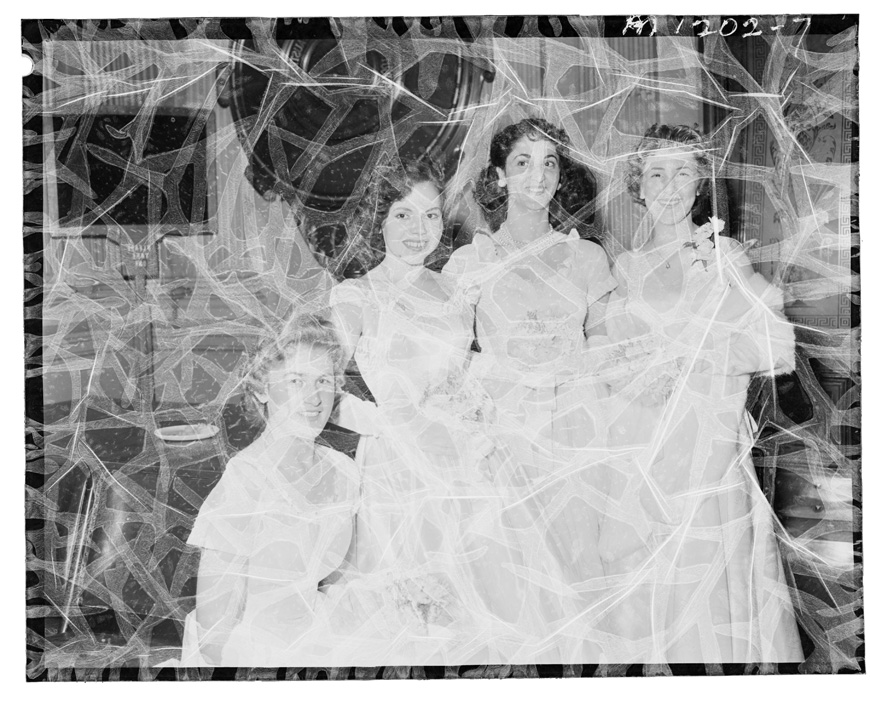Photographic conservators work with photographic media, including photographic and digital prints, film and negatives.
Paper conservators are trained to work with photographic material as both can feature cellulose as a base ingredient. However the range of different types of photographs printed on plastic, glass and metal mean the photographic conservator is highly specialised in their own right. Photographic conservators study the history of photography, identification of photograph types, photographic preservation, conservation treatments and the display of photographic materials
Physical damage
Photographs are highly sensitive and can be torn, scratched and abraded through mishandling. The emulsion layer of a photograph is commonly made from gelatine and albumen. The smooth and sensitive surface of this film can split or crack if not stored or handled carefully.
Labelling photographs on the reverse using a pen can fracture the emulsion on the image. Soft pencil is a better alternative.
Paper clips are another common cause of damage, alongside repairs using self adhesive sticky tapes. Tapes grow acidic, and cause discolouration that is often insoluble in water and is irreversible.
Biological damage
This can occur through mould or pest damage. Mould thrives on gelatine emulsions and will result in the eventual loss of image. Mould is activated in conditions of high relative humidity especially in environments of over 65%.
Photographs with ‘active’ mould must be taken away from non-affected collection items and dealt with appropriately.
Gelatine or albumen based emulsions are a food source for insects and thrive in the same conditions as mould, resulting in damage to the paper support and emulsion layer of a photograph. Other pests such as insects and rodents particularly enjoy eating organic cellulose material, along with dust, adhesives and sizes on photographs that may contain animal-based glues.
Chemical damage
Chemical deterioration may occur in the support layer of a photograph (made of paper, plastic, glass or metal), in the emulsion layer, image layer or materials that the photograph has been mounted on. Reactions can cause discolouration, seen as yellow or silvering occurring over a prolonged period of time.
In very dry conditions, photographs may become embrittled and risk delamination. They may also curl, as the photo paper and emulsion give off moisture at different rates. On the other hand, very humid environments increase chemical activity and present ideal conditions for mould growth and insects.
Different kinds of paper may contain different levels of acidity inherent in the manufacturing process, or may have been introduced to an adhesive or mount that is acidic, a factor that causes the material to become unstable.
Photographs with a silver-based emulsion suffer oxidation, resulting in a stained, yellowed and faded appearance. This may occur because of fluctuations in relative humidity, poor storage or due to chemical residue on the image.
Fading can result from prolonged exposure to ultraviolet radiation in light. Natural light contains high levels of UV radiation which is damaging to paper objects. If exposed to high levels of light for prolonged periods of time, paper supports may yellow and become embrittled, and gelatine binders may begin to break down.
Plastic film supports, such as cellulose nitrate or acetate, are inherently unstable. Such photographs including film, and motion picture film, may suffer deformation and creasing. They can release a sticky residue and toxic gas when subjected to high temperatures and fluctuations in relative humidity. Freezing objects significantly slows this type of degradation.
Treatments
When damage does occur, photographic conservators use a variety of methods to halt deterioration, minimise the aesthetic distraction from damage on a work, and ensure the work can be handled, displayed, stored or digitised.
By researching the materials of a work, including the photograph type and any other materials used, photograph conservators use their knowledge to make the most effective treatment decisions.
Treatments for photographs often include dry cleaning to remove surface dirt. This might incorporate the use of smoke sponges, erasers, brushes and vacuum methods.
Backing removal is often required when photographs have been adhered to a backing board or other object that is causing chemical or physical damage. This process involves mechanical scraping using tools designed to remove layers of a backing gradually in order to free the object.
Lining a photograph may be necessary when it is very fragile, contains many tears and requires extra support for display or handling. Using diluted starch paste, conservators coat the reverse side of a photograph and line it with a suitable conservation-grade paper chosen for its weight, texture and appearance. Photographs that do not require lining but have tears are treated locally with fine Japanese tissue paper and starch paste.
AICCM has a Special Interest Group for those interested in the conservation of photographs. Join this group, contribute to its activities, or speak to a specialist conservator.
Need a conservator? Find one here.
Resources
- Caring for your photographs (National Film and Sound Archive)
- Caring for photographs (State Library of Victoria)
- Preserving photographs (National Archives of Australia)
- Conservation of photographs (Australian War Memorial)
- Graphics Atlas (Image Permanence Institute)
- Caring for film (National Film & Sound Archive)
- Technical Preservation Guide (National Film & Sound Archive)
- Preserving microforms (National Archives of Australia)
- Preserving motion picture film (National Archives of Australia)